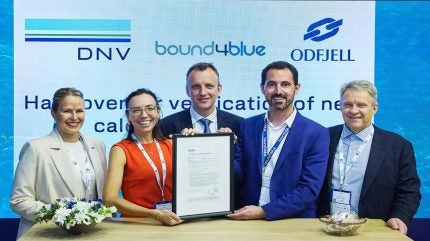
bound4blue, a Spanish company providing automated wind-assisted propulsion systems, has received validation from Norway’s classification society DNV for wind propulsion system force matrix calculation method.
The validation offers shipowners, designers, and shipyards a “regulation-ready” tool to assess the performance of bound4blue’s eSAIL suction sail technology without the requirement of a full-scale testing.
According to bound4blue, this approach can conserve both time and resources by providing a forecast on fuel savings, emissions reductions, return on investment, and regulatory advantages for each vessel.
Commenting on the validation, bound4blue co-founder and chief technical officer David Ferrer said: “This is a crucial development. The validation not only confirms the accuracy of our performance assessments, but also ensures they are immediately applicable for compliance with today’s most important environmental regulations.
“It simplifies decision-making for stakeholders and removes uncertainty when evaluating wind-assisted propulsion.”
The force matrix methodology enables precise estimation of the thrust produced by eSAILs across a range of wind and sailing conditions.

US Tariffs are shifting - will you react or anticipate?
Don’t let policy changes catch you off guard. Stay proactive with real-time data and expert analysis.
By GlobalDataDNV’s validation indicates that the results have been generated using a tool that complies with international rules and standards.
This methodology can now be applied in calculations for essential regulatory frameworks, including EEDI (Energy Efficiency Design Index) and EEXI (Energy Efficiency Existing Ship Index), and FuelEU Maritime, stated the company.
DNV Maritime chief operating officer Cristina Saenz de Santa Maria stated: “As the decarbonisation timeline becomes clearer and regulatory pressure intensifies, we need to ensure that our stakeholders can make confident decisions when adopting energy-enhancing technologies. Performance benefit claims should be credible, comparable, and transparent, to accelerate the uptake of greener technologies.
“At DNV we want to make sure that when shipping companies invest in greater sustainability, they can be sure they are making a difference to both their competitiveness and to the environment. That’s why we are pleased to work with technology suppliers like bound4blue who are committed to transparency and independent validation to robust technical standards.”
The methodology enables the assessment of any individual vessel, and provides results generated through a blend of data derived from wind tunnel tests, computational fluid dynamics (CFD) simulations, and potential flow models.
This method facilitates the evaluation of various sail configurations and their interactions.
bound4blue has recently received orders for its fully autonomous suction sails from companies such as Maersk Tankers, Marflet Marine, and Klaveness Combination Carriers.
Additionally, new installations have been completed for Odfjell, Eastern Pacific Shipping, and Louis Dreyfus Company.
These systems can be easily installed on retrofits and new builds and require no operational involvement from the vessel crews, stated the company.
Wind propulsion solutions, including suction sails, are said to be gaining acceptance due to the introduction of the FuelEU Maritime regulation.
The eSAIL solution can be deployed to tankers, bulkers, Ro-Ros, cruises, ferries, gas carriers, and general cargo vessels.
In early May, bound4blue announced the installation of what it claimed as the “largest” suction sails in the world, with four 26m high eSAILs fitted to the MV Atlantic Orchard.
The vessel is owned by Wisby Tankers and chartered by Louis Dreyfus Company.



